Vampires might not be the first thing that come to mind when we look at the ruins of Melrose Abbey today. This wasn’t always the case though!
Deeds of the undead are wrapped up in the long history of the abbey. A centuries old story of an evil entity known as the ‘Hundeprest’, or dog-priest, is one of the most spine-chilling tales of medieval Melrose.
Let’s put some Bauhaus tunes on and peer into the murky depths of the folklore of Melrose. We’ll start with a retelling of the legend and then take a look at some of the history around it.
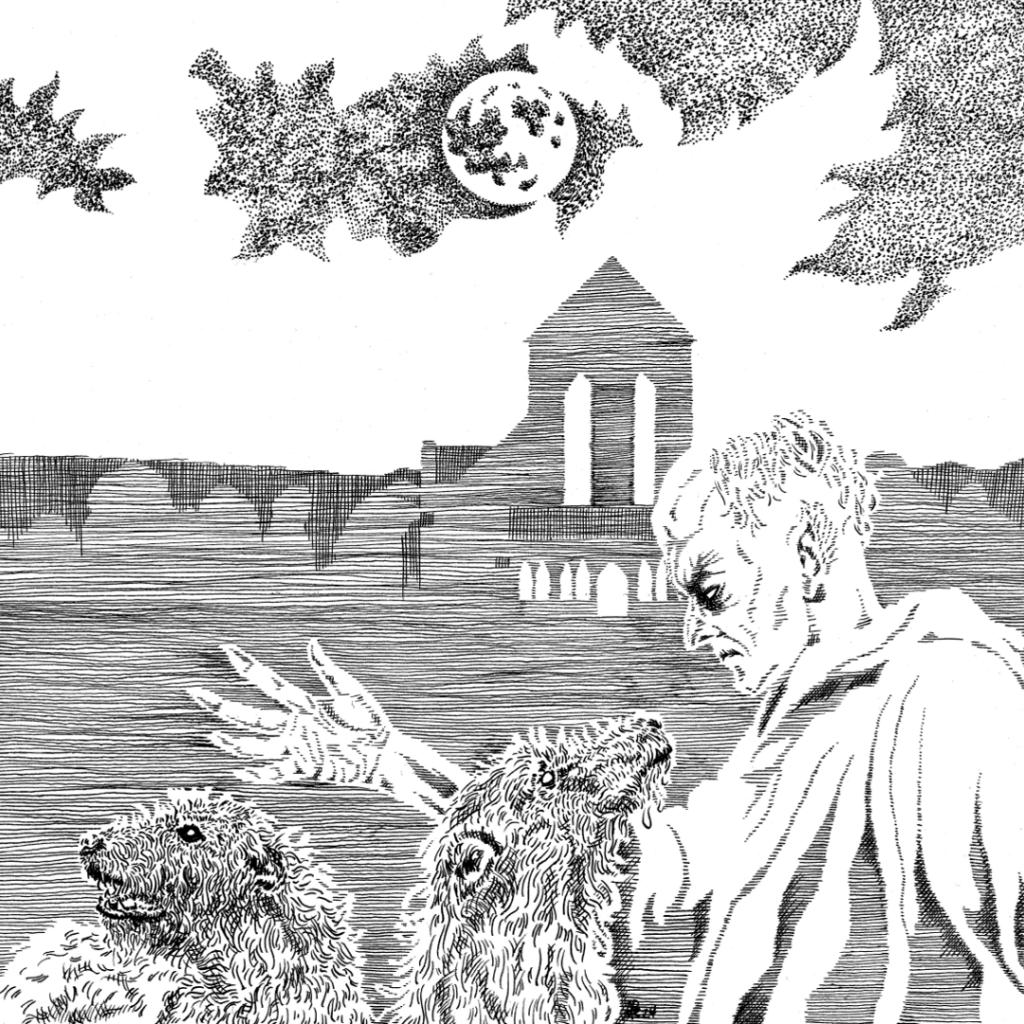
Illustration of the Melrose Vampire by Allan MacRitchie.
The Hundeprest
The ‘Hundeprest’, or dog-priest, had led a less than holy life. He preferred a life of hunting with dogs rather than tending to the spiritual needs of his congregation. His reputation amongst his fellow clergy wasn’t great, and nobody was too upset when he finally passed away. Being the chaplain of ‘a certain illustrious lady’ meant that he had the honour of being buried in the graveyard at Melrose Abbey in the spring of 1196.
However, death didn’t mean that his spirit was finally at peace. He regularly rose from his tomb at night to wander the lands around Melrose, terrorising the monks of the abbey. The monks prevented him from injuring or terrifying those within its sacred walls. They prayed to stop him coming across the threshold. Defeated by the word of God, and rather than returning to his grave, he roamed the countryside around the town. Eventually he came to the house of his former mistress. Hovering above her bedchamber, he would murmur and groan loudly, putting her into a fair old state of fear.
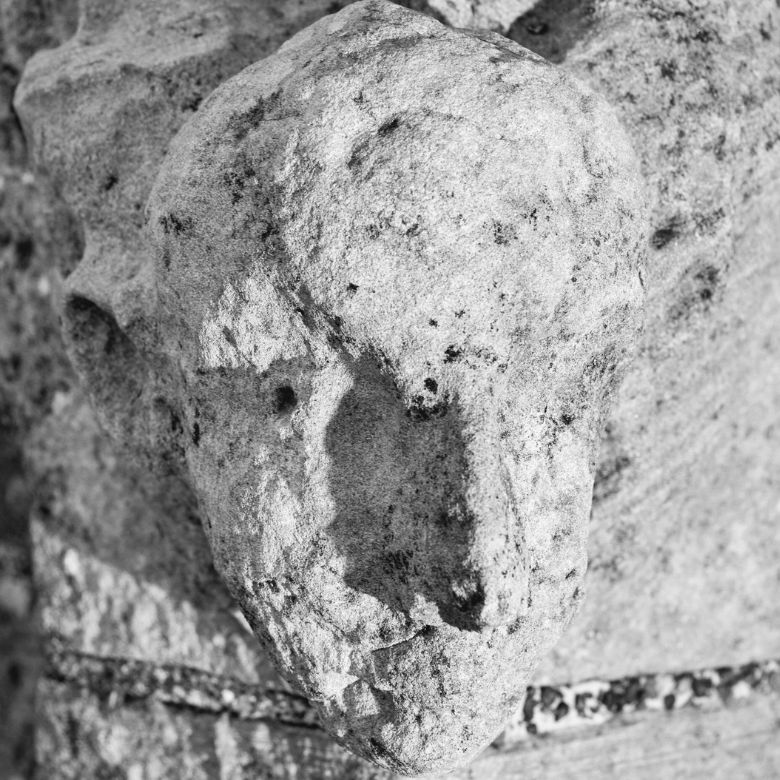
This grotesque adorns the walls of Melrose Abbey. With his large nose, prominent teeth and exaggerated eyebrows, he looks a lot like the vampire in the 1922 film ‘Nosferatu’.
Who you gonna call? Hundeprest-busters!
This went on for some time with the Hundeprest visiting the house on several occasions, scaring her a little more every time. With tears in her eyes, she demanded a friar, visiting from the abbey on church business, should pray more earnestly than usual on her behalf to help relieve her of the risen dead. The monk, knowing how great a benefactor of the abbey she was, promised he would do what he could and quickly. This pious lady couldn’t continue to put up with such disturbances by the undead, especially a spirit as loathsome as the Hundeprest!
On returning to the abbey, he assembled a party consisting of himself and three other monks to keep guard over the cemetery where the supernatural creature lay. The monks were armed in preparation for a confrontation with the Hundeprest. The night was cold, and no monster had arisen after the passing of midnight. The three monks who had been engaged as assistants decided to nip into the nearest house to heat their chilled bones. Bolstered by his own sense of courage, the monk remained at his post, just in case…
An unholy sight
And now the soulless monster seized his chance! Rising from his lair, he faced down the lone monk. He thought his terrifying appearance would scare his guard away and allow him to roam free. Initially the monk faltered but quickly regained his courage. He had nowhere to hide, so he valiantly stood his ground against the apparition. With a terrible roar, the creature rushed at the monk, hoping to scare him off and allow the continued frightening of his mistress.
The fearless monk brought up the axe in his hand and struck out at the fiend, driving it deep into its body. With a roar, the Hundeprest groaned loudly and fled back in the direction of his grave, closely pursued by his pious opponent. As they ran, the monk compelled the monster to retreat to back his tomb for good.
The commotion brought the other three monks back out into the cold of the graveyard. They too joined in the pursuit of their undead opponent. With the dog-priest back in his grave, they all waited until the light of dawn… just in case the creature tried to rise again. On opening the grave, they found the corpse of their enemy. Blood and gore were still flowing from a large axe wound.
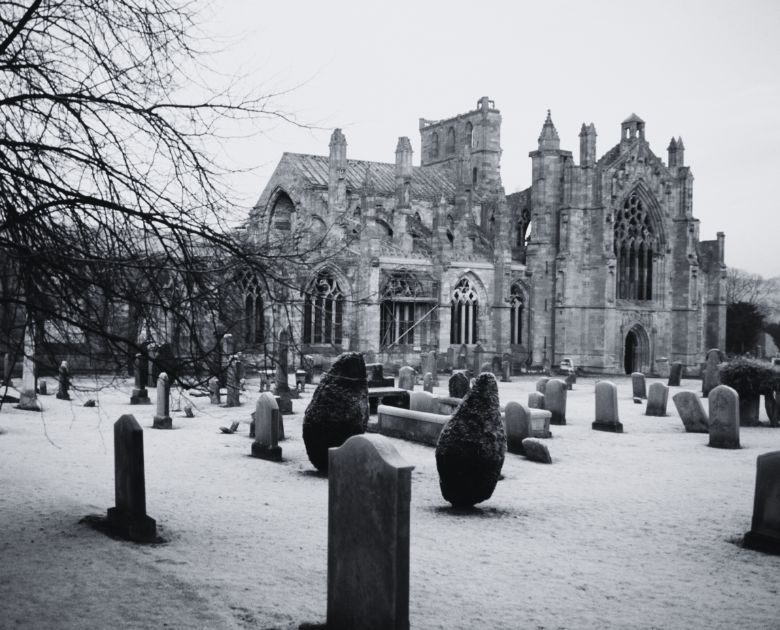
The graveyard at the ruins of Melrose Abbey.
Between them, they removed the body from its tomb and carried it outside the precincts of the abbey. Once it was beyond the holy soil, they burnt the body to prevent it from returning to the abbey. The ashes were then scattered to the winds. The Hundeprest would terrorise Melrose no more.
Listen to the story
Did you know that we produced an audio version of this story for visitors to Melrose Abbey to enjoy? Listen in to actor Douglas Russell telling the story here:
The abbey in the time of the Melrose Vampire
The story of the wayward priest resurrected from the dead was first recorded in 1197. This was just 61 years after David I founded the abbey at Melrose.
Melrose Abbey was the first Cistercian monastery in Scotland. It was one of a number of abbeys that David I set up in the Borders. He was keen to show both his piety and his power over this contested territory. The king invited Cistercian monks from Rievaulx Abbey in Yorkshire, to set up his new abbey.
Only a very small part of the first abbey church survives. In 1385, Richard II attacked Melrose Abbey and the abbey church had to be entirely rebuilt. The present building of rose-coloured stone dates almost entirely to the post-1385 rebuilding.
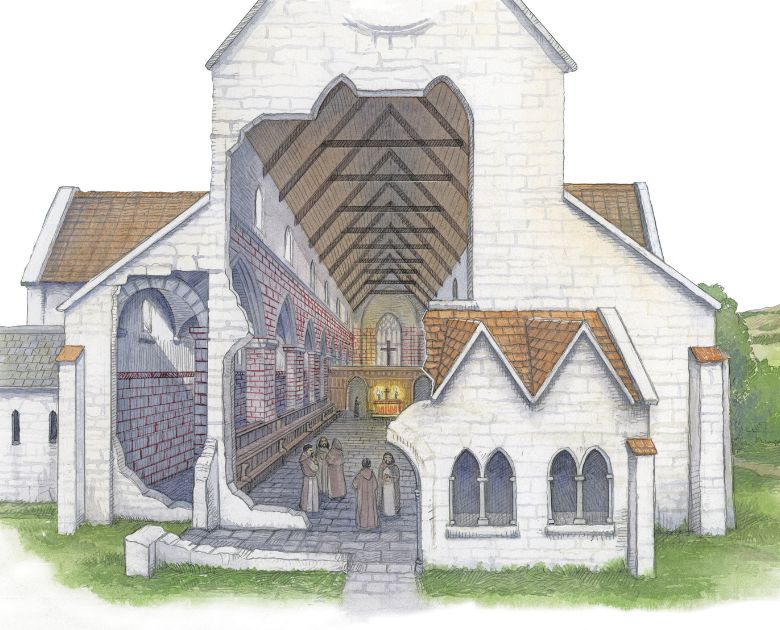
How Melrose Abbey may have looked in the early 1200s. Illustration by Brian Lee.
This burial canister in our collections is one of the few surviving objects from the abbey’s early history. It was found during excavations in the 1920s. The canister was taken to the Museum of Antiquities (now the National Museum of Scotland) for opening. Records state that the contents were “a few fragments of bone and two teeth”.
The canister was thought to be from a 12th century head burial. In the 12th century the head was considered the focal point for burials. Sometimes the head of the deceased would be propped up on stones, surrounded by wooden planks to frame it and protect it. There are also instances where the head was removed and placed in a canister like this. These practices were in order for the head to be upright and able to see Christ when Judgement Day arrived. There’s no suggestion this canister is connected to the story of the Melrose Vampire!
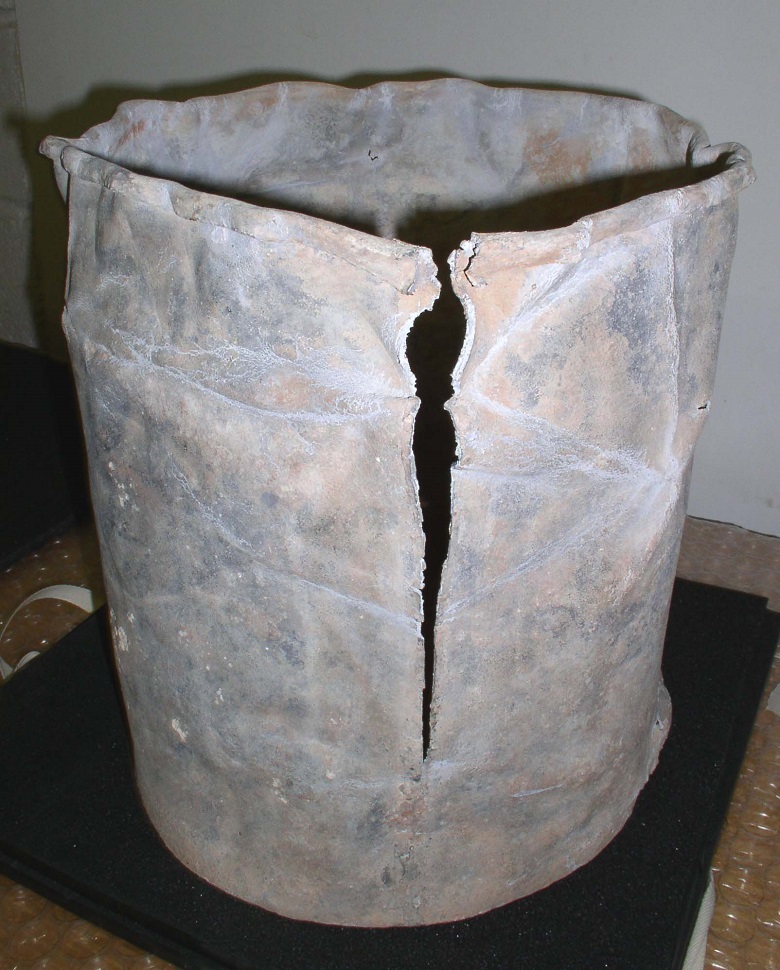
12th century lead burial canister from Melrose abbey.
William of Newburgh and his revenants
The story of the Hundeprest was first told by a Yorkshire monk and historian called William of Newburgh. Writing at the end of the 12th century, he recorded several fascinating stories of people risen from the dead.
In his ‘History of English Affairs‘ (which chronicles England’s history from 1066 to 1198), William introduces the goings on at Melrose by saying:
It would not be easy to believe that the corpses of the dead should sally (I know not by what agency) from their graves, and should wander about to the terror or destruction of the living, and again return to the tomb, which of its own accord spontaneously opened to receive them, did not frequent examples, occurring in our own times, suffice to establish this fact, to the truth of which there is abundant testimony.
In medieval times the animated spirits or corpses of the dead were known as ‘revenants’, derived from the Old French for ‘returning’. Tales of revenants were popular during the medieval period. It’s likely that they were used by the clergy as a way to warn people of the consequences of living a less than holy life.
Revenant vs Vampire
Today most of us are more familiar with the idea of ‘vampires’ than ‘revenants’.
The word ‘vampire’ comes from the Old Slavic and Turkic word onpyr, which is a combination of the words ‘vam’, meaning blood, and ‘pir’, meaning monster. The earliest known reference to a vampire is from an Old Russian text written in 1047. According to the Oxford English Dictionary, the word ‘vampire’ first appeared in English in 1734, more than 500 years after William of Newburgh recorded his story of the revenant.
The greatest ever vampire story – Dracula – was published by Bram Stoker in 1897. The immediate success of the novel renewed popular interest in vampires.
When did the Hundeprest revenant become a ‘vampire’? Certainly by 1916. In their book ‘Stories of the Border Marches’, John and Jean Lang were already referring to him as a vampire.
Interestingly, it was the work of a woman born in the Scottish Borders in 1849 which was instrumental in inspiring Bram Stoker’s Dracula. Find out about Emily Gerard and her work on Transylvanian folklore in this other blog.
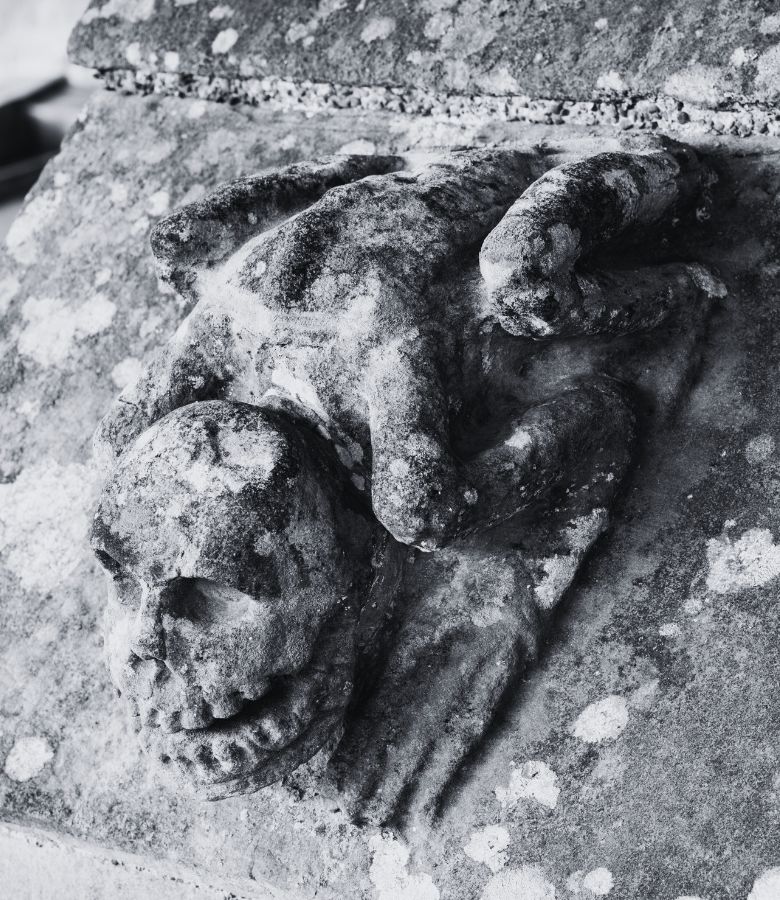
Another grotesque featured on Melrose Abbey, carved after the 1385 rebuilding of the abbey.
The truth of the tale
Sadly, William’s recounting of this horror doesn’t include any names. Is the story based on real people living in and around Melrose in the late 1100s? It’s likely we’ll never know.
What we do know is that the people of Melrose can sleep sound in their beds tonight. Sceptics know the Hundeprest never really existed. Believers can rest assured that over 800 years ago, four brave monks banished the Melrose Vampire to hell.
Discover more stories from Scotland supernatural past.

